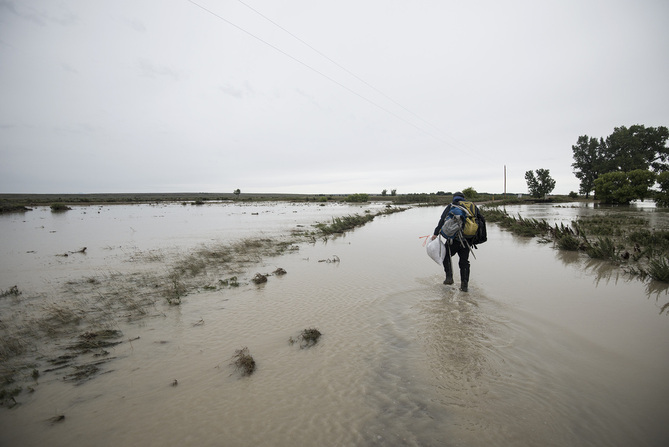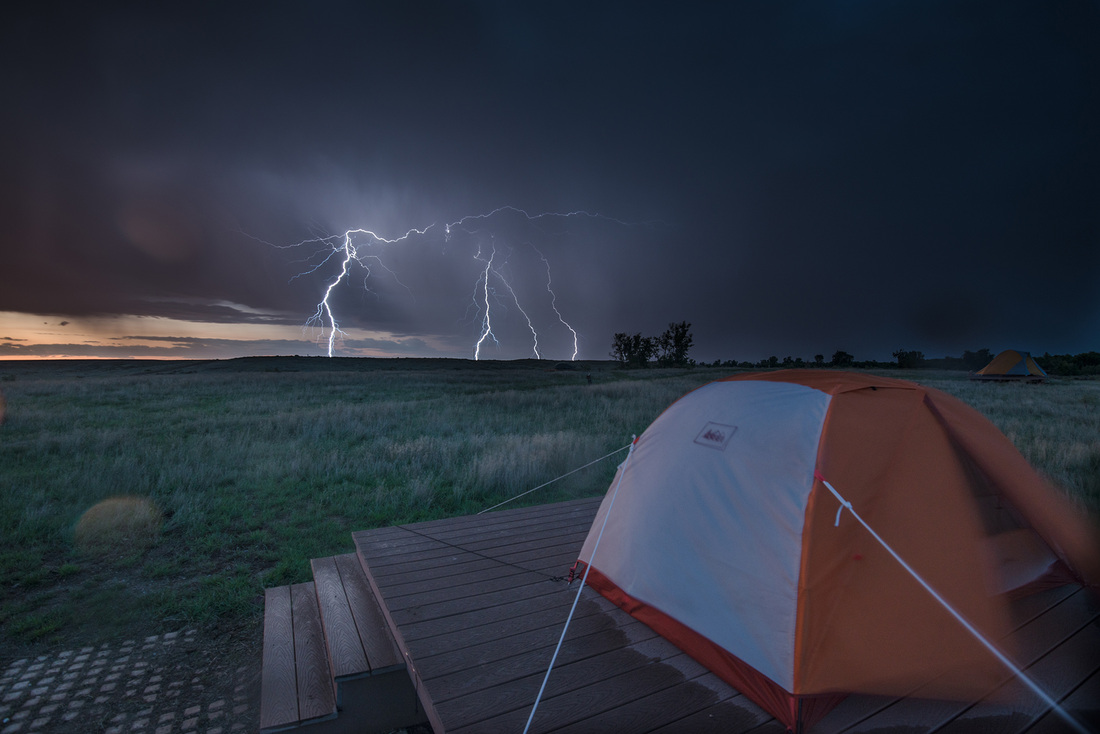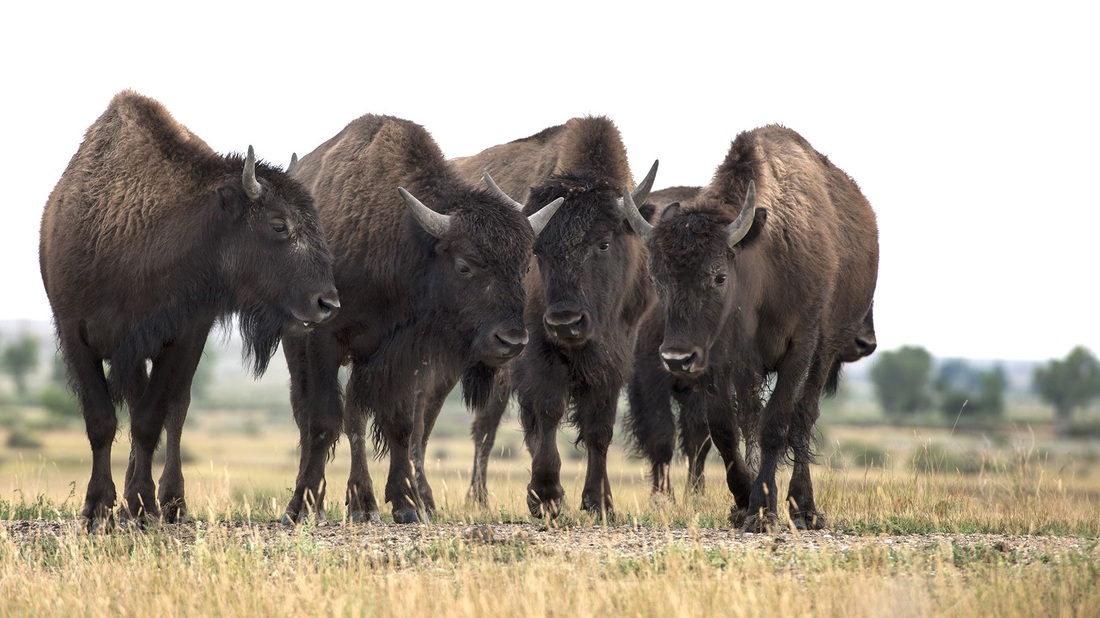Landmark is ASC’s groundbreaking project to provide “boots on the ground” support for the American Prairie Reserve management team. Wildlife survey crews consist of skilled outdoors men and women who live and work on Montana’s northern Great Plains, collecting data that informs APR’s conservation management decisions.
Story and Photos By Morgan Cardiff
You feel the wind first: a few fresh gusts that relieve some of the day’s heat and force the mosquitoes into hiding. Within the hour you’re scrambling to stop your tent from blowing to the next county.
During this particular storm, the first drops began to fall around midnight, a slow but constant tapping on my tent. I woke about four hours later, when, my tent lying half-destroyed around me, I had to look for alternative sleeping arrangements.
Over the next 36 hours, the rain continued to fall. Bone-dry creek beds turned into raging torrents, effectively isolating the Landmark crew on what was now our Sun Prairie Island. We had just received eight inches of rain in a 48-hour period. The average rainfall for the town of Malta, 40 miles to the north of the Sun Prairie, is 12 inches.
You feel the wind first: a few fresh gusts that relieve some of the day’s heat and force the mosquitoes into hiding. Within the hour you’re scrambling to stop your tent from blowing to the next county.
During this particular storm, the first drops began to fall around midnight, a slow but constant tapping on my tent. I woke about four hours later, when, my tent lying half-destroyed around me, I had to look for alternative sleeping arrangements.
Over the next 36 hours, the rain continued to fall. Bone-dry creek beds turned into raging torrents, effectively isolating the Landmark crew on what was now our Sun Prairie Island. We had just received eight inches of rain in a 48-hour period. The average rainfall for the town of Malta, 40 miles to the north of the Sun Prairie, is 12 inches.
“That was the third 100-year storm in three years” said Damien Austin, the American Prairie Reserve Operations Manager, a few days later.
I’d read about the brief but intense northern Montana summer, with its 90-degree temperatures, big blue skies and the occasional super cell storm crossing the prairie. My first two weeks on the Landmark crew provided just that. This, however, was something different.
Even after a short period of time out here, you start to pick up on the subtleties: how most of the storms track west to east, dropping sporadic rainfall in their wake; that a dragonfly sounds terrifyingly like the prairie rattlesnake; and how a whole herd of bison seem to appear and vanish like a ghost in the night.
The “Great Storm of August 2014” was not one of those super cell storms I so wished to photograph. Winds howled from the east, the sky remained gray, rain fell constantly, and we were trapped for what seemed like days and days in our small camper. Not the Montana summer I expected.
Calling to check on our cabin fever status, ASC Program Manager Mike Kautz, mentioned something along the lines of an “unprecedented event.” I liked the thought of that. I tend to be attracted to extremes—extremes of weather, of human passion and endurance.
I came here for that extreme and for the opportunity to contribute to a long-term vision. It’s refreshing to remember there are still environments where we cannot be dominant. They remind us we are not always in control, and that we must live in the moment, submitting to the forces and learning to live within their bounds. I get the feeling life out here accepts this proposition, and those who couldn’t accept that have long gone.
The “Great Storm of August 2014” was not one of those super cell storms I so wished to photograph. Winds howled from the east, the sky remained gray, rain fell constantly, and we were trapped for what seemed like days and days in our small camper. Not the Montana summer I expected.
Calling to check on our cabin fever status, ASC Program Manager Mike Kautz, mentioned something along the lines of an “unprecedented event.” I liked the thought of that. I tend to be attracted to extremes—extremes of weather, of human passion and endurance.
I came here for that extreme and for the opportunity to contribute to a long-term vision. It’s refreshing to remember there are still environments where we cannot be dominant. They remind us we are not always in control, and that we must live in the moment, submitting to the forces and learning to live within their bounds. I get the feeling life out here accepts this proposition, and those who couldn’t accept that have long gone.
The days of waiting out the flooding rains, of gale force winds that could blow my tent to the Little Rocky Mountains—they all add to the experience.
While the storm bought destruction, it also bought life. Fields transformed into what I can only assume resembles spring, and the bison have become playful again after the stifling heat of early August. Describing the plague of mosquitoes that brought havoc to my sanity as “horrendous,” fails to describe in even a remote sense their effect.
Life in northeastern Montana is not easy, but it is unique. I am looking forward to what the rest of my time will bring. I believe it could snow tonight.
While the storm bought destruction, it also bought life. Fields transformed into what I can only assume resembles spring, and the bison have become playful again after the stifling heat of early August. Describing the plague of mosquitoes that brought havoc to my sanity as “horrendous,” fails to describe in even a remote sense their effect.
Life in northeastern Montana is not easy, but it is unique. I am looking forward to what the rest of my time will bring. I believe it could snow tonight.
Morgan was born and raised in a small town on the east coast of Australia. He has a degree in Environmental Science and is working toward a masters in Natural Resource Management in Munich, Germany. Find more of Morgan’s work at rhysmorganimages.com





